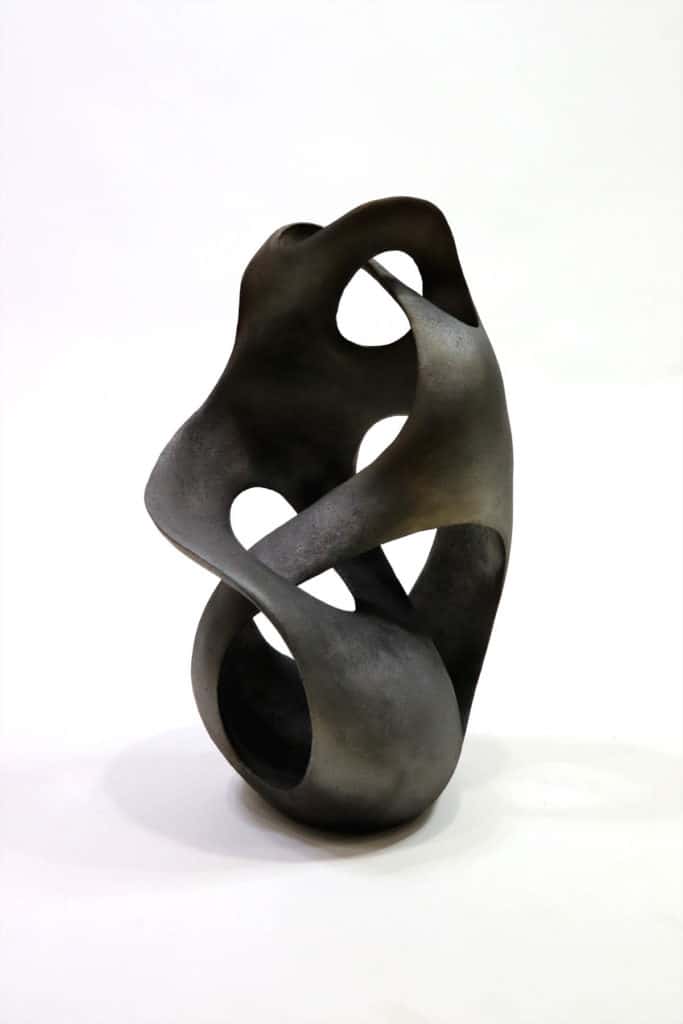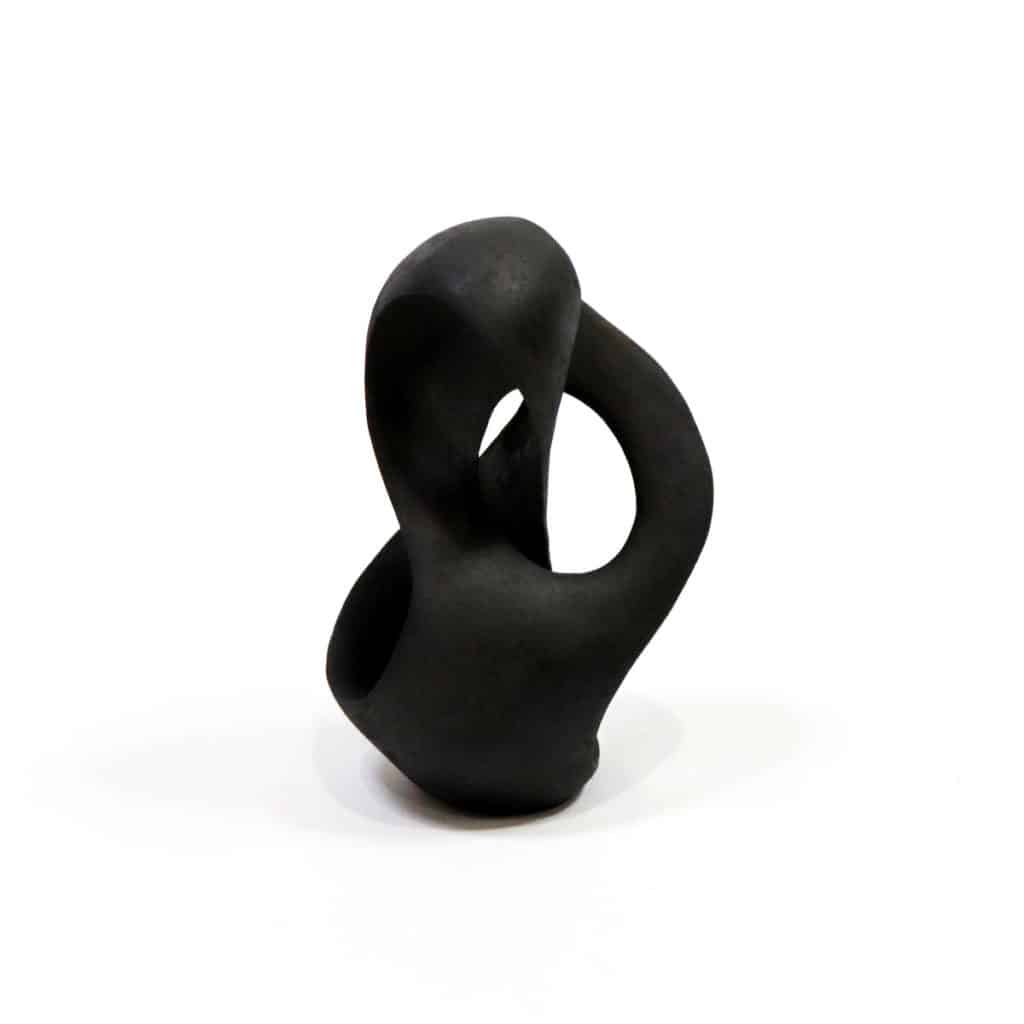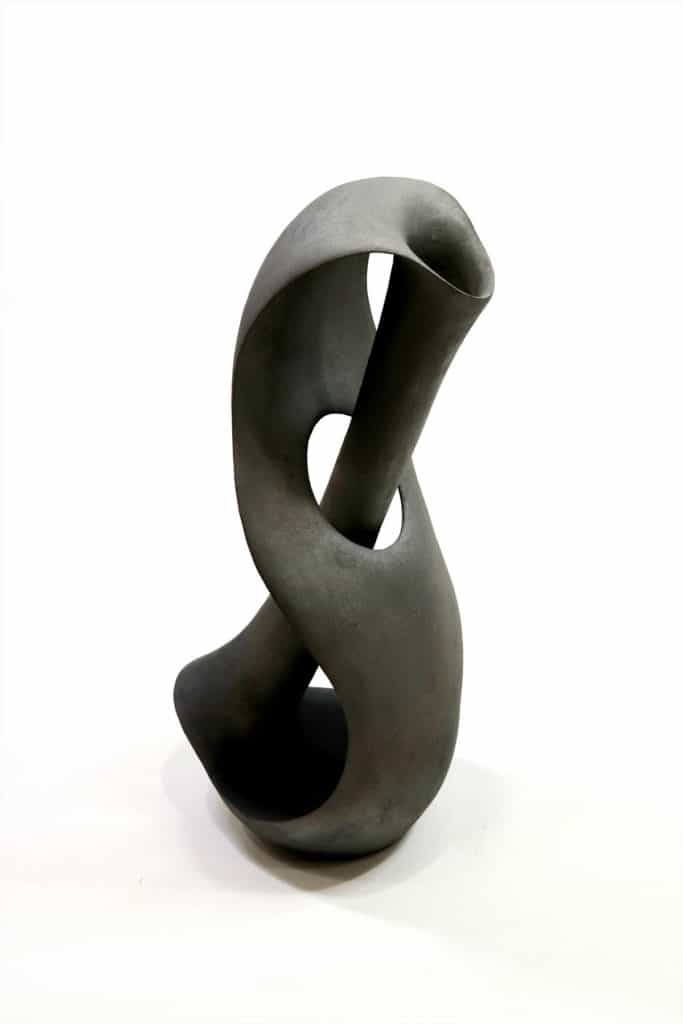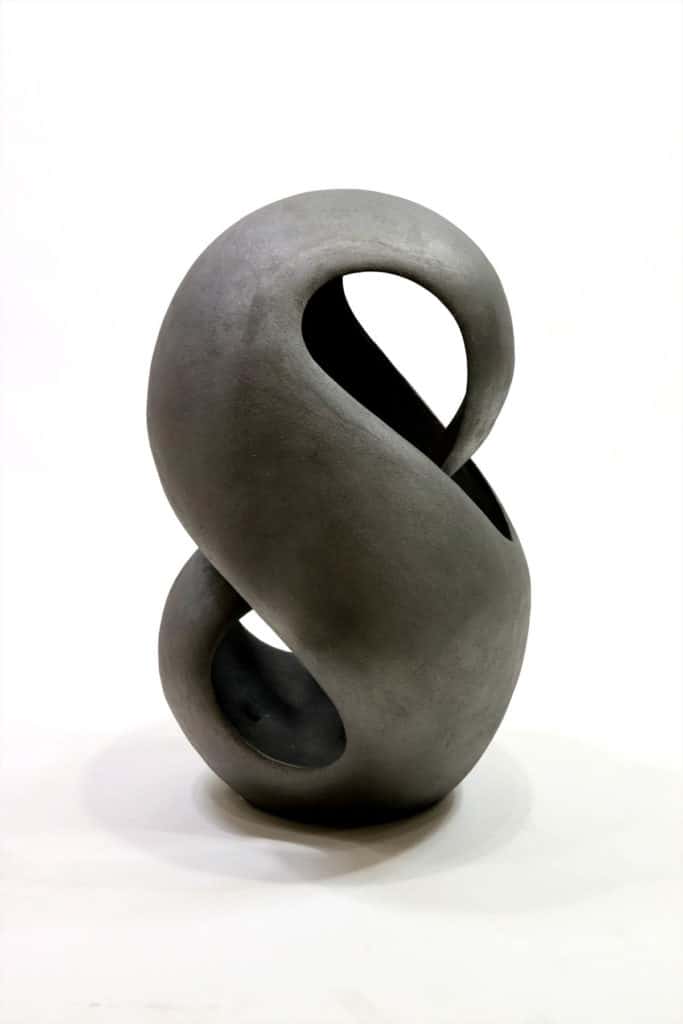- Toru Kuwakawa, 交, Cross, 2018, H51×W30×D30㎝, smoke firing
- Toru Kuwakawa, 胚, Embryo, 2018, H94×W34×D34㎝, smoke firing
- Toru Kuwakawa, めぐる♯2, Circulate♯2, 2018, H18×W12×D9㎝, smoke firing
- Toru Kuwakawa, 蛇 snake, 2018, H88×W43×D35㎝smoke firing
- Toru Kuwakawa, 循環, Circulation, 2018, H60×W38×D43㎝, smoke firing
While we think of Kyoto as a place of craft traditions, our Japan issue revealed another side to its creative energy: modernist innovation. Kevin White’s article about Sodeisha and Mitsuo Shoji’s reflection on originality both locate Kyoto as a centre where new ideas emerge. We see this again today in the exhibition by Toru Kurokawa titled String Theory at Gallery Sokyo. Curator Tomohiro Daicho writes about the artist’s quest to give expression to “savage math” of clay.
“The moment I encounter a law is when I am happiest.” Toru Kurokawa
Toru Kurokawa’s works, which express physically abstract beauty, are composed of strings. Their surfaces are layered upwards from the bottom surface. The surfaces push against each other so that inside becomes outside and dimensions and spaces shift back and forth. His commitment to using strings to make things comes from string theory, which holds that “the particles from which all things come from are made of infinitesimally small strings.” Another source of Kurokawa’s works is the topological theorems seen in the Möbius strip, the Klein bottle and the Poincaré conjecture. By continually asking himself, “What does it mean to make forms?” Kurokawa uses his instinctive sense and reason to express an original mathematical world like that of the geometrical shapes seen in outer space and the natural world. Since 2008, rather than using black ceramic, he creates works using a “silver-black ceramic” that crystallizes coal by firing it at high temperatures in order to give his forms a more distinct appearance. “Silver-black ceramic” takes on many different expression according to what the light is like at a given time or naturally occurring changes. Starting in 2018, Kurokawa has taken on what is for him the new material of metal and created a work made of two intertwined loops, entitled “Oxymoron.” This show uses a new concept that approaches ceramics works by interacting with metal to overlap and extend loops. While creating with clay must contend with the serious constraint of gravity, Kurokawa says he wishes to express the softness and approachability only found in clay.
String Theory is at Sokyo Gallery, Kyoto, 2-27 February 2019.
This is a reflection on the work of Toru Kurokawa by Tomohiro Daicho:
In January 2017, Toru Kurokawa’s solo exhibition “The Savage Math” was held at Gallery Sokyo in When I hear the phrase, “The Savage Math,” which is also the title of a Kurokawa piece, I am reminded of Claude Lévi-Strauss’s notable and similar sounding work “The Savage Mind.” In this book, the author dismantled the common illusion that two different types of thinking exist, namely that of civilized man and so-called savage man. Using the term “savage thought” he explained that mythical and magical thinking can be found everywhere in the formation of civilized daily life and set it against “modernistic thought.” If the meaning of savage and wildness is regarded as one of the systems that give structure to people’s lives, although it apparently deviates from the “rationality” and “efficiency” so beloved of modern science, then, such “savage thought” would be strongly involved in artistic expression.
Now we must consider the “savage math” of Kurokawa, the ceramic artist. When we re-examine the “savage” is probably suited to expression in earthenware as they have a high degree of primitiveness in their production. However, “savage” does not mean the kind of work that simply and directly shows clay materials and traces of artistic acts, nor is it derived from the positioning of ceramics as something pristine, pure, and closely related to everyday life as symbolized by the folk-arts movement. These two approaches form the main current in ceramic expression; however, at the same time, it would seem that the media of ceramics disguises “naturalness.” This “naturalness” is notably found in cracks, fractures, self-glazing, or deformation during firing, and such spontaneous elements have given rise to many theories of ceramic expression, but the results derived from them often end up as ambiguous or romantic. In contrast, Kurokawa’s approach is not to camouflage the “naturalness” in ceramics; rather, with mathematical and intellectual thinking he gives shape and freshly systematizes the “savage nature” possessed by ceramics in a manner quite different from the rational approach of modern science.
When we observe one of Kurokawa’s works, we often find the regular repetition of a certain spatial unit giving rise to the entire unity of a piece. This is the basic structure of the artist’s works. Since the surface configuration is apparently based on such a rational approach, the production methods of his works could be replaced with shaping methods using other materials or a modern 3D printer. Certainly, if we focus only on the superficial geometric pattern development, it is possible to produce works with a more complicated structure because the increased strength of such materials as metal enables any number of repetitions, but when we closely observe them in detail, it is clear that they are not formed by scientific rationality alone. It is because ceramic works require production space, distinctive material qualities and conditions, myriad techniques, and production processes such as drying, glazing, and firing; moreover, through each step, any ceramic piece is significantly subject to the force of gravity. In a typical Kurokawa work, by first accepting the primeval characteristics of ceramic production and materials, and then incorporating “mathematical” models suitable to ceramics he transforms such limitations into a visual representation. The consequent results are the harmonious combination of geometrically continuous and repetitive spatial structures and smooth forms; in this way, by interacting with “ceramics” in the course of production he expresses himself as an artist. This is already seen in his seminal work “undulation,” which received the Choza Grand Prize at the 28th Chozasho Contemporary Ceramic Art Exhibition in 2007 and put Kurokawa firmly on the artistic map. In this work, by joining gradually widening tubules, he combined the order of nature, ceramic material, and an intrinsic rule resulting from the production process. Some ten fruitful years later, his work “undulation” can now be described as his starting point, and this initial vision has deepened with a stronger visual clarity, and we can see the Kurokawa of today proclaiming “The Savage Math.”
Tomohiro Daicho
Curator
National Museum of Modern Art, Kyoto






